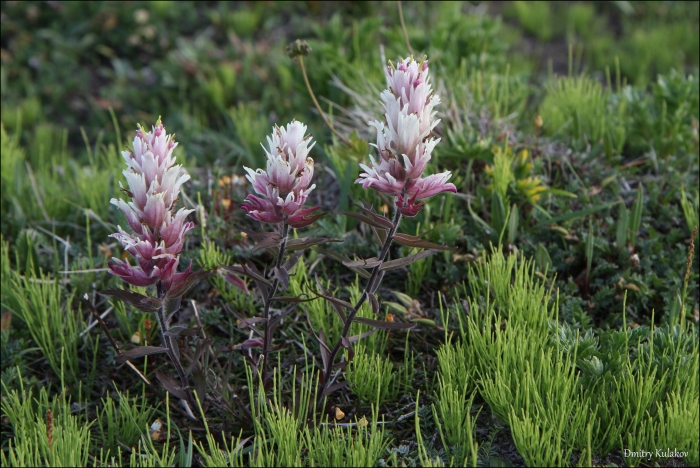Pale Indian Paintbrush
(Castilleja pallida)
Pale Indian Paintbrush (Castilleja pallida)
/
/

Dmitry Kulakov
CC BY 4.0
Image By:
Dmitry Kulakov
Recorded By:
Copyright:
CC BY 4.0
Copyright Notice:
Photo by: Dmitry Kulakov | License Type: CC BY 4.0 | License URL: http://creativecommons.org/licenses/by/4.0/ | Rights Holder: Dmitry Kulakov | Publisher: iNaturalist | Date Created: 2013-08-02T11:21:48-07:00 |

























Estimated Native Range
Summary
Castilleja pallida, commonly known as Pale Indian Paintbrush, is a perennial herb native to a variety of habitats across North America and Russia, including prairies, meadows, open woodlands, and moist areas. It typically grows to a height of 1-2.5 feet (0.3-0.8 meters). This species is characterized by its unique inflorescences, which consist of bracts that are often mistaken for petals; these bracts can be pink, green, or white and are quite showy when they bloom in the summer. The actual flowers are small and inconspicuous, nestled among the colorful bracts.
Pale Indian Paintbrush is valued for its ability to add splashes of color to wildflower gardens and naturalized areas. It is a hemiparasitic plant, meaning it derives some of its nutrients from the roots of neighboring plants, which should be considered when planting. It is used for its ornamental value and is also important for native pollinators. In cultivation, it prefers full sun to part shade and thrives in medium draining loam or sandy soils with medium moisture. While it is not a high-maintenance plant, it can be challenging to establish due to its parasitic nature. It is not commonly afflicted by diseases but can suffer from root rot if overwatered or planted in poorly draining soils.CC BY-SA 4.0
Pale Indian Paintbrush is valued for its ability to add splashes of color to wildflower gardens and naturalized areas. It is a hemiparasitic plant, meaning it derives some of its nutrients from the roots of neighboring plants, which should be considered when planting. It is used for its ornamental value and is also important for native pollinators. In cultivation, it prefers full sun to part shade and thrives in medium draining loam or sandy soils with medium moisture. While it is not a high-maintenance plant, it can be challenging to establish due to its parasitic nature. It is not commonly afflicted by diseases but can suffer from root rot if overwatered or planted in poorly draining soils.CC BY-SA 4.0
Plant Description
- Plant Type:
- Height: 1-2.5 feet
- Width: 0.5-1 feet
- Growth Rate: Moderate
- Flower Color: Green, Pink, White
- Flowering Season: Summer
- Leaf Retention: Deciduous
Growth Requirements
- Sun: Full Sun, Part Shade
- Water: Medium
- Drainage: Medium
Common Uses
Bee Garden, Butterfly Garden, Low Maintenance
Natural Habitat
Native to prairies, meadows, open woodlands, and moist areas across Eastern North America
Other Names
Common Names: Pale Paintbrush , Prairie Indian paintbrush , Pale Indian paintbrush
Scientific Names: Castilleja pallida , Bartsia acuminata , Bartsia pallida , Bartsia rubricoma , Bartsia sibirica , Castilleja acuminata , Castilleja acuminata , Castilleja angustifolia , Castilleja pallida , Castilleja pallida f. tincta
GBIF Accepted Name: